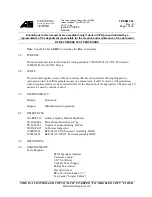
Operating the C7-613
5-18
C7-613 Control System
A5E00138934-03
•
Fault messages
– Are messages on faulty operations or state faults, e.g. “Motor temperature
too high” or “Valve does not open”,
– Fault messages are displayed immediately and appear as flashing
messageson the display
– Fault messages must always be acknowledged
– Are displayed in the message level as long as they are pending.
– Are entered in the event buffer
Messages that are pending or that arrive during STOP mode, POWER OFF,
parameter assignment, a language change, are signaled again as arrived and
unacknowledged once the mode is terminated or the function is completed.
Double entries which are caused by a STOP/RUN operating mode transition are
identified by the entry of the operating mode transition in the diagnostic buffer of
the CPU.
In addition to status messages, operator instructions can also be specified as fault
messages. For example, if a machine operator wants to start the filling process but
forgot to open the water supply at the mixer, he can be prompted with a fault
message to remedy the error.
Messages can contain a static text and a maximum of four variable output fields. In
the variable fields, the values that are current at the time the message appears are
shown in a numerical display.
All operational and fault messages are stored in the C7-613 in an event buffer.
Each status change in a message leads to a new entry in the event buffer. All
messages currently in the buffer can be viewed on the display.
Message Bit Procedure for Operational/Fault Message
While the process is in operation, if the precondition is met for outputting an
operational/fault message (for example, a setpoint has been reached), the user
program must set a bit in the message area (“EVENTS” parameter of
“HMI_EVENT” FB) for operational/fault messages. After calling “HMI API” FB and
the “HMI_EVENT” FB, the data area is evaluated. As a result, a message is
recognized as “arrived” and entered in the event buffer. Fault messages are
displayed immediately and appear as flashing messages on the display The user
program must reset the bit in the message area when the precondition for
outputting the message is no longer met. The message is then considered to be
“gone”.
Information regarding the data areas is provided in Section 4.6.1.
Содержание SIMATIC C7-613
Страница 14: ...Contents xiv C7 613 Control System A5E00138934 03 ...
Страница 56: ...Special Features of the C7 613 3 10 C7 613 Control System A5E00138934 03 ...
Страница 90: ...Integration into the User Program 4 34 C7 613 Control System A5E00138934 03 ...
Страница 134: ...Maintenance 6 4 C7 613 Control System A5E00138934 03 ...
Страница 160: ...A 26 C7 613 Control System A5E00138934 03 ...
Страница 176: ...B 16 C7 613 Control System A5E00138934 03 ...
Страница 192: ...C 16 C7 613 Control System A5E00138934 03 ...
Страница 198: ...Index Index 6 C7 613 Control System A5E00138934 03 ...
















































